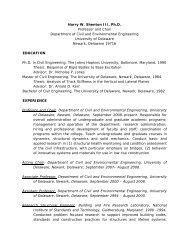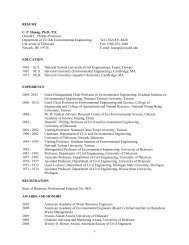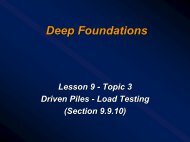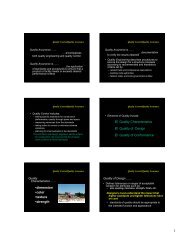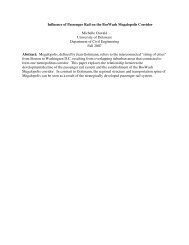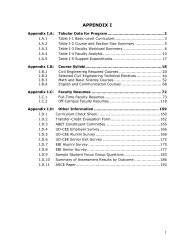Teamwork and Technical Writing - University of Delaware
Teamwork and Technical Writing - University of Delaware
Teamwork and Technical Writing - University of Delaware
Create successful ePaper yourself
Turn your PDF publications into a flip-book with our unique Google optimized e-Paper software.
<strong>Teamwork</strong> <strong>and</strong> <strong>Technical</strong> <strong>Writing</strong>A Group Dynamics Modulefor <strong>Technical</strong> <strong>Writing</strong> 410Michael PearlmanEnglish Department<strong>University</strong> <strong>of</strong> <strong>Delaware</strong>
<strong>Teamwork</strong> <strong>and</strong> <strong>Technical</strong> <strong>Writing</strong>Table <strong>of</strong> Contents1. BECOMING PART OF THE GROUP .............................................. 3THE ADVANTAGES OF COLLABORATION ................................................... 3ANALYZING FOUR CLASSIC POTENTIAL GROUPPROBLEMS 2 ........................................................................................... 4INDIVIDUAL ACCOUNTABILITY .................................................................. 5EIGHT ELEMENTS NECESSARY FOR GROUPEFFECTIVENESS .................................................................................... 52. PLANNING FOR THE PROJECT ................................................... 7PREPARATION ....................................................................................... 7BRAINSTORMING.................................................................................... 7DEFINING TASK TYPES ........................................................................... 73. CREATING AND REVISING THE DOCUMENT ............................. 9SIX DIFFICULTIES ASSOCIATED WITH COLLABORATIVEWRITING (AND POSSIBLE SOLUTIONS) ...................................................... 94. CONCLUSION................................................................................11HOW TO ASSEMBLE, ORGANIZE, AND GUIDE A WRITINGTEAM...................................................................................................115. WORKS CITED ..............................................................................14APPENDIX 1: GROUP MEMBER EVALUATIONINSTRUCTIONS FOR MAJOR GROUP PROJECT..............................15APPENDIX 2: MULTI-MEDIA................................................................162
<strong>Teamwork</strong> <strong>and</strong> <strong>Technical</strong> <strong>Writing</strong>3. The need for "continuity <strong>and</strong> reliability" - Having a group <strong>of</strong> writersworking on a project instead <strong>of</strong> just one individual ensures that the projectwill still be completed successfully even if one <strong>of</strong> the members <strong>of</strong> thegroup is incapacitated.Analyzing Four Classic Potential Group Problems 21. Only one or several members <strong>of</strong> the group complete the bulk <strong>of</strong> thework while the rest <strong>of</strong> the group members function as spectators - Toprevent this common problem, group members must assess each othersstrengths, talents, <strong>and</strong> weaknesses <strong>and</strong> tasks must be assignedaccordingly. Each member <strong>of</strong> the group should be responsible for aportion <strong>of</strong> the work before the actual work is initiated.2. Each group member has a different idea about how the work shouldproceed - To prevent differences <strong>of</strong> opinion from stalling the project, themembers <strong>of</strong> the group must focus on effective strategies as part <strong>of</strong> anentire gameplan to keep the project moving forward. Group membersshould assume separate tasks. Each individual will probably beresponsible for a portion <strong>of</strong> the work, create his/her own schedule, <strong>and</strong>develop a commitment to have the work completed on time. Some tasksmust be completed by everyone working together (for example, planningthe report outline or drafting the overview). Peer pressure must be exertedfor each individual to meet deadlines.3. Portions <strong>of</strong> the project are completed by individuals without thereview <strong>of</strong> the entire group, resulting in several fragmented parts thatcannot be unified into a single document - Issues <strong>of</strong> style <strong>and</strong>organization must be determined before the document is written. Whenindividuals are assigned to submit drafts sections, the team should definein advance the requirements for those sections (Notes on a yellow pad?Library note cards? Well written text that is ready to go? Formatted <strong>and</strong>clean copy?) One or possibly two group members should be appointed tothe task <strong>of</strong> overseeing the editing process; however, all members <strong>of</strong> thegroup must review each portion <strong>of</strong> the document <strong>and</strong> participate in its finalediting <strong>and</strong> organization.4. Conflict <strong>and</strong> disagreement among team members creates anatmosphere <strong>of</strong> mistrust <strong>and</strong> inhibits productivity - Anticipatedifferences with other group members but recognize that only compromise<strong>and</strong> cooperation will result in the project's successful outcome. Someforms <strong>of</strong> conflict, i.e. substantive conflict, can actually be beneficial asdisagreement over the substance or strategyy <strong>of</strong> the project or documents<strong>of</strong>ten leads to a higher quality outcome. 3 Personal conflict (whenindividuals simply don’t like each other or can’t get along) must berecognized <strong>and</strong> addressed with c<strong>and</strong>or <strong>and</strong> directness, using interpersonalcommunication skills. Procedural conflict (who must do what, when, towhat st<strong>and</strong>ard) should be addressed through formulating plans, st<strong>and</strong>ards,<strong>and</strong> shared agreements on work processes. Success will only be achieved4
<strong>Teamwork</strong> <strong>and</strong> <strong>Technical</strong> <strong>Writing</strong>through "patient, active participation by team members in sharing insights,resolving conflicts, <strong>and</strong> coordinating work activities." With all groupmembers focused on the desired goal, communication should be open<strong>and</strong> immediate so that problems are solved as soon as they arise.Individual AccountabilityTo insure that the work involved in each project is being distributed fairly amongthe individual members <strong>of</strong> each group a system <strong>of</strong> individual accountability mustbe devised. Students who contribute more than their fair share <strong>of</strong> responsibilityfor the project should be amply rewarded, while students who do not carry theirweight should be penalized. Students should be informed about the rewards/consequences <strong>of</strong> positive group participation or lack there<strong>of</strong> in advance <strong>and</strong> suchinformation should follow a thorough discussion <strong>of</strong> the instructor's expectationswith respect to group participation, including a substantial portion <strong>of</strong> in-class timefocused on group dynamics such as those outlined in this course module.Appendix 1 - Group Evaluation Instructions for Major Group Project,provides an example <strong>of</strong> such a system. This system involves an anonymousstudent survey so that each group member can evaluate the performance <strong>of</strong>each <strong>of</strong> the other members in his/her group. Unbiased group evaluation surveys,such as this one, are effective when they have an impact on a student's finalgrade. See Appendix 1.Eight Elements Necessary for Group EffectivenessJarvis identifies eight elements necessary for group effectiveness: 41. Shared underst<strong>and</strong>ing <strong>of</strong> general <strong>and</strong> specific objectives. The entireteam as a group as well as each individual member has a clearunderst<strong>and</strong>ing <strong>of</strong> team goals, both general <strong>and</strong> specific. Each teammember is familiar with his/her responsibilities <strong>and</strong> contributes to thegroup effort accordingly. Priorities are recognized <strong>and</strong> an attitude <strong>of</strong>compliance in order to achieve objectives is maintained. Throughout theproject, team members reevaluate these objectives <strong>and</strong> develop a sense<strong>of</strong> team awareness to avoid confusion <strong>and</strong> frustration, which mightcircumvent team effectiveness.2. Openness <strong>and</strong> confrontation. An atmosphere <strong>of</strong> open expression ismaintained in which each group member feels comfortable volunteeringopinions <strong>and</strong> providing feedback to other group members. Groupmembers are able to confront problems, mistakes <strong>and</strong> difficulties withoutthe fear <strong>of</strong> vindication by other group members.3. Support <strong>and</strong> trust. Working relationships that express trust <strong>and</strong> supportresult from an open-minded attitude, empathy, <strong>and</strong> a positive approach tothe opinions <strong>of</strong> others. "Ideally, the team can be an open, supportive,unthreatening environment but in reality there is <strong>of</strong>ten too much at stake5
<strong>Teamwork</strong> <strong>and</strong> <strong>Technical</strong> <strong>Writing</strong>between people at work (personal rivalry, politics) to make deep personalexchanges with others an easy process."4. Co-operation <strong>and</strong> conflict. Group members participate in friendlycompetition, each generating <strong>and</strong> expressing helpful ideas <strong>and</strong>suggestions in an effort to benefit the entire group. Rather than promotinghidden agendas <strong>and</strong> personal stereotypes, conflict functions to provokecreativity. The whole is more effective than the sum <strong>of</strong> its individual parts.5. Sound procedures. Team procedures should be carefully planned <strong>and</strong>executed. These procedures, including "the calling <strong>of</strong> meetings…teamnotes, records, etc," should function to streamline team activity <strong>and</strong> helpteams to avoid becoming bogged down with excessive bureaucracy.While leadership is important to the decision-making process, it is crucialthat consensus among all team members be reached before a decision isimplemented.6. Appropriate Leadership. Team leaders must be able to comm<strong>and</strong>energy, competence, <strong>and</strong> an ability to mediate among other teammembers. In addition, "planning, initiating, organization, <strong>and</strong> controllingskills," are requisite for team objectives to be realized. Team leadersshould serve the group <strong>and</strong> consider their first priority the collectiveinterests <strong>of</strong> the whole.7. Regular Review (both task level <strong>and</strong> interpersonal). Regular review <strong>of</strong>team objectives <strong>and</strong> the means to achieve such objectives should occupyan important position on a team's agenda. Such reviews should beundertaken collectively <strong>and</strong> should focus on both task <strong>and</strong> interpersonalissues. At the task level, group members should examine projectobjectives, appropriate orientation to such objectives, <strong>and</strong> desired results(substantive issues). At the interpersonal level, group members shouldexamine issues that might be holding the group back such as individualmembers' inabilities to accept the opinions <strong>of</strong> others, receive feedback,<strong>and</strong> engage in compromise to the benefit <strong>of</strong> the entire group (personalissues). At the project level, teams should continually assess progresstoward goals <strong>and</strong> adapt the workplan, roles, <strong>and</strong> responsibilities asnecessary (procedural issues).8. Individual development. Each group member must feel that there issomething in it for me. Individual development <strong>and</strong> growth are importantbarometers in gauging the success <strong>of</strong> the entire group effort. Once thegroup project has been completed, each individual should come awayfrom the experience with a sense <strong>of</strong> personal, as well as collective,accomplishment. It is a good practice to debrief with the team <strong>and</strong> reflecton what went well, what caused problems, <strong>and</strong> what lessons can be takenaway from the project.6
<strong>Teamwork</strong> <strong>and</strong> <strong>Technical</strong> <strong>Writing</strong>2. Planning for the ProjectPreparationBefore the writing begins, "the team collectively identifies the audience (orclient), the purpose <strong>and</strong> goals, the scope <strong>of</strong> the project, <strong>and</strong> the deliverables(documents, presentations, artifacts or products). When the deliverable is adocument, the team analyzes the overall project, conceptualizes the work to beproduced, creates a broad outline <strong>of</strong> the document, divides the document intosegments, <strong>and</strong> assigns each segment to individual team members, <strong>of</strong>ten on thebasis <strong>of</strong> expertise. In the planning stage, the team projects a schedule <strong>and</strong> setsany writing style st<strong>and</strong>ards that team members are expected to follow." 5Preparation involved finding out who has what skills <strong>and</strong> trying to align expertisewith project roles <strong>and</strong> responsibilities.BrainstormingBrainstorming, a necessary precursor to problem-solving <strong>and</strong> successfullycompleting a project, can be defined as a collective activity which providesinsight into solving a particular problem. Insight, in turn, can be defined as "aradically new way <strong>of</strong> seeing the subject that discloses intellectual boundaries <strong>and</strong>is simple yet permanently true." Insight is <strong>of</strong>ten achieved when "a multi-facetedproblem is recognized; the problem is confronted in its fullness <strong>and</strong>complexity; <strong>and</strong> the problem is considered not only with the intellect butalso with emotions, attitudes, <strong>and</strong> beliefs." 6 There are three benefitsassociated with insight:1. Insight leads to action.2. Insight brings relief because it results in solving problems.3. Insight creates new under-st<strong>and</strong>ings.Effective brainstorming in groups, both in discussion <strong>and</strong> on paper leads to thecreation <strong>and</strong> implementation <strong>of</strong> creative ideas which move a project forward.Early brainstorming as the team formulates the project goals can help avert“group think,” where someone suggests an idea <strong>and</strong> everyone agrees becausethey are not really thinking <strong>of</strong> alternative <strong>and</strong> other possibilities.Defining Task TypesMorgan suggests that tasks can be divided into four categories: 71. Individual tasks - "are unitary tasks that cannot reasonably be brokeninto constituent parts <strong>and</strong> may be best accomplished by one person."Creating only individual tasks <strong>of</strong>ten results in fragmentation among groupmembers as each focuses only on his/her particular assignment.2. Melding tasks - "cannot be broken down into subtasks. And all groupmembers are needed to accomplish the task." Such tasks require allmembers <strong>of</strong> the group to reach a consensus before the work is begun.7
<strong>Teamwork</strong> <strong>and</strong> <strong>Technical</strong> <strong>Writing</strong>3. Aggregate tasks - "a task that any one group member cancomplete…(but) <strong>of</strong>ten requires a number <strong>of</strong> operations that allows groupmembers to take on different subtasks." These tasks "call for a highdegree <strong>of</strong> coordination among group members, even if members areessentially doing the same task within a project."4. Interdependent tasks - "is a divisible task…all members must contributeto complete the assignment successfully." In this case, each member <strong>of</strong>the group is assigned a responsibility <strong>and</strong> all members must fulfill theirrespective responsibilities to successfully complete the assignment.While each <strong>of</strong> these four categories has its respective place in collaborativewriting, most <strong>of</strong>ten, successful groups emphasize melding, aggregate, <strong>and</strong>interdependent tasks in their group work, as such tasks require that eachmember <strong>of</strong> the group participate actively in the collaborative writing process.8
<strong>Teamwork</strong> <strong>and</strong> <strong>Technical</strong> <strong>Writing</strong>3. Creating <strong>and</strong> Revising the DocumentSix Difficulties Associated with Collaborative <strong>Writing</strong>(<strong>and</strong> possible solutions)Farkas (his principles quoted in bold) <strong>of</strong>fers six difficulties associated withcollaborative writing along with possible solutions. 81. Highly integrated documents are very complex artifacts. As complexartifacts, documents <strong>of</strong>ten include flaws which cause them to be less thansuccessful. A failing document may result from, "missing information,illogical or nonfunctional organization, <strong>and</strong> inconsistencies in point <strong>of</strong> viewor treatment <strong>of</strong> subject." Ultimately, all documents contain both strong <strong>and</strong>weak points but when the weak points outnumber the strong points, thedocument becomes untenable. To avoid the above possibilities,collaborative writers must actively scrutinize their documents collectively<strong>and</strong> depend upon one another to employ objective <strong>and</strong> constructivecriticism.2. The process <strong>of</strong> preparing a document becomes more complex whenit is performed collaboratively. Creating <strong>and</strong> preparing a document isalready a complex process when performed by an individual; it becomeseven more complex when undertaken by a group. “The (individual) writermust maintain control <strong>of</strong> the theme, the organizational structure, the level<strong>of</strong> detail, the tone, <strong>and</strong> all other aspects from beginning to end.” To createa successful document, all members <strong>of</strong> the writing team must have acollective image <strong>of</strong> the desired outcome. Tasks must be disseminated toeach individual, a comprehensive schedule must be developed so thatthose whose task is dependent upon the completed work <strong>of</strong> others, willreceive such work in a timely manner, <strong>and</strong> individual work must be revisedto facilitate the collective image, as well as to correct individual errors <strong>and</strong>insufficiencies.3. The writing process generates strong emotional commitments. Astrong commitment to one’s own personal style <strong>of</strong> writing <strong>of</strong>ten createsdifficulties in collaborative writing projects. Team members who "regardtheir component <strong>of</strong> a collaborative work as a private document <strong>and</strong>assume the prerogatives <strong>of</strong> traditional ownership" jeopardize the groupwriting process <strong>and</strong> provoke unnecessary conflict at the entire group'sexpense. Those who are strongly committed to high quality work shouldfind ways to focus this attitude on efforts to facilitate teamwork <strong>and</strong> pride ina successful collaborative outcome.4. Documents are reworkable <strong>and</strong> are subject to infinite revision.“Although thorough revision is an important component in all forms <strong>of</strong>writing, group members should be discouraged from "excessivereworking." Such obsessive fastidiousness (while perhaps uncommon9
<strong>Teamwork</strong> <strong>and</strong> <strong>Technical</strong> <strong>Writing</strong>among student writing groups) can create individual burn-out <strong>and</strong> teamdiscord.5. Collaborative writers lack fully adequate terms <strong>and</strong> concepts withwhich to create a clear <strong>and</strong> precise common image <strong>of</strong> the documentthey wish to produce. “Writers work with one <strong>of</strong> the most elusive <strong>and</strong>poorly understood materials—language—<strong>and</strong> so they generally useconcepts <strong>and</strong> terms that are imprecise <strong>and</strong> deficient for communicationamong team members.” To mitigate this problem, it is useful for teams <strong>of</strong>writers to create “preliminary <strong>and</strong> partial representations <strong>of</strong> the finishedproduct.” By creating outlines, prototypes, partial rough drafts, <strong>and</strong> byreviewing portions <strong>of</strong> a document throughout the different stages <strong>of</strong> itsdevelopment, collaborative writers can become more certain <strong>of</strong> reaching aconsensus about the meaning they wish to convey in the final draft.6. It is difficult to predict or measure success. "Documents take theirmeaning <strong>and</strong> achieve their effects in the minds <strong>of</strong> readers, <strong>and</strong> therefore itis difficult to predict whether a document will achieve the intended results.”Groups should seek feedback from sources both within the classroom <strong>and</strong>outside <strong>of</strong> the classroom to predict <strong>and</strong> measure as objectively as possiblethe potential for the success or failure <strong>of</strong> the documents they produce.Attention should be given to both form <strong>and</strong> content.10
<strong>Teamwork</strong> <strong>and</strong> <strong>Technical</strong> <strong>Writing</strong>4. ConclusionHow to Assemble, Organize, <strong>and</strong> Guide a <strong>Writing</strong> TeamThe following comes from Robert Underwood, a senior technical writer atLockheed:As a senior technical writer in my division, I'm usually the first to hearabout a major writing project. I get the news by phone call or memo froman upper-level manager. The next step is a meeting with him or her tolearn as much as I can about the project: what's expected <strong>of</strong> me, whatresources are available, when the project must be completed, who willreview our work, <strong>and</strong> so forth. I take careful notes at this meeting; theinformation gathered there must be shared accurately with the writingteam I'll be putting together.I'm usually given some freedom in selecting members for thewriting team. After eleven years with the company, I think I know thestrengths <strong>and</strong> weaknesses <strong>of</strong> our various staff writers. Some are knownfor their thoroughness <strong>and</strong> attention to detail, others for their speed indrafting, <strong>and</strong> others for content knowledge <strong>and</strong> organizational abilities.My goal is to shape a team that includes all these strengths.I try to determine approximately how many writers I'll need on theteam, then add one more. Too large a team can't work in a coordinatedway <strong>and</strong> too small a team gets swamped by the workload. I don't put thesame people together on the same teams time after time. That approachleads to an "A Team," "B Team" mentality that hurts morale. Wheneverpossible, I try to involve at least one new writer on major projects. H<strong>and</strong>sonexperience is the only way to grow.Once I've selected team members <strong>and</strong> notified them <strong>of</strong> our firstmeeting, I put together a folder <strong>of</strong> project information for each participant.The more information we can share from the beginning, the moreproductive our initial meetings. The first meeting is a bit more social thanlater meetings. It's important that we all get to know one another <strong>and</strong> totrust one another. If we're going to speak frankly about what we like <strong>and</strong>don’t like in each other's writing, we have to establish a bond <strong>of</strong> goodfellow-feeling from the beginning. Otherwise, the work <strong>of</strong> the group willbreak down because <strong>of</strong> personality conflicts <strong>and</strong> petty disagreements.I try not to dominate the first meeting <strong>of</strong> the team. I've learned thatthe more I talk at the first meeting, the more <strong>of</strong> the project I'll have to doon my own. My goal is to present what I know about the project asconcisely as possible, then to open up discussion for the opinions,questions, <strong>and</strong> suggestions <strong>of</strong> team members. I explain why we're doingthe project, who will read it, <strong>and</strong> how much time <strong>and</strong> money the companywants to spend on it.11
<strong>Teamwork</strong> <strong>and</strong> <strong>Technical</strong> <strong>Writing</strong>By the end <strong>of</strong> the meeting, our discussion will hopefully lead to atleast three initial decisions on the part <strong>of</strong> the team: (1) when to meet again;(2) what each member will bring to that meeting; <strong>and</strong> (3) what additionalinformation we need as a group to proceed with our work. I don't try tocome up with a working outline or document design at the first meeting.These decisions, made too early or by only one person, can discouragefresh thinking by the group.At the second meeting, I listen for interest areas. By this time,each team member has had a chance to think through the project <strong>and</strong> todecide, in a tentative way, where he or she can make a contribution. Teammembers will tell me what they want to do if I listen well enough. I'velearned that they do their best work in their areas <strong>of</strong> special interest. Oncewe've settled upon areas <strong>of</strong> responsibility, we make plans for drawing up atentative outline. This master agenda for our document will change manytimes during the writing process. But it's important to make a start--to getsome kind <strong>of</strong> orderly thoughts on paper. We also set approximatemilestones for our work. Although these may change, we have to considerthe resource <strong>of</strong> time from the very beginning <strong>of</strong> the project.At the following meetings, we will refine our master outline, thenmove on to the document design, drafting, review, <strong>and</strong> revision stages.Our work in these areas has been made much easier in the last few yearsby groupware, a form <strong>of</strong> word-processing s<strong>of</strong>tware designed specificallyfor team writing. Using groupware, we can each work at our computerson our assigned portions <strong>of</strong> the document while having the work <strong>of</strong> otherteam members always accessible at the same computer. Here's a list <strong>of</strong> thecapabilities <strong>of</strong> our groupware:1. All team members see document changes suggested by others.2. Changes can be discussed on screen before becoming part <strong>of</strong> thedocument draft.3. Team members can send comments, questions, <strong>and</strong> data to one anotherduring the writing process.4. Team members can develop, <strong>and</strong> switch back <strong>and</strong> forth to, alternativepatterns <strong>of</strong> organization, types <strong>of</strong> graphics, <strong>and</strong> tentative drafts.During the outlining <strong>and</strong> drafting stages, I keep in close touch with uppermanagement to make sure the team is heading in the right direction. Too <strong>of</strong>ten inthis company, as in others, a writing team has completed a major project withoutconsultation with management along the way. The result can be a wasted effort,squ<strong>and</strong>ered resources, <strong>and</strong> sometimes even terminations.We formalize the review process by management when the team hascompiled its first edited draft. This prototype is circulated among upper managersfor their sign-<strong>of</strong>f <strong>and</strong> suggestions. We revise accordingly.The team usually settles upon one or two members to act as final editorsfor the last draft. It's important that each page <strong>of</strong> the document read as if it were12
<strong>Teamwork</strong> <strong>and</strong> <strong>Technical</strong> <strong>Writing</strong>written by one person, although in fact many team members contributed. Weachieve this sense <strong>of</strong> a single voice "speaking" in the document by limiting thenumber <strong>of</strong> final editors. The completed document is then given to each teammember for a painstaking final reading. We want to eliminate all errors in form,content, grammar, mechanics, style, usage, <strong>and</strong> spelling.I usually invite a senior manager to our final team meeting to receive thecompleted document. It's important that all team members share in the sense <strong>of</strong>accomplishment that comes with the presentation <strong>of</strong> the document tomanagement. Managers have a chance to ask questions about the document at themeeting, <strong>and</strong> to thank those who worked on it. Although I probably shouldn't sayit, we writers value this last meeting as a chance to tell senior managers what's inthe document. Often their reading <strong>of</strong> our work isn't as thorough as it should be. 913
<strong>Teamwork</strong> <strong>and</strong> <strong>Technical</strong> <strong>Writing</strong>5. Works Cited1. Blair, Gerard M. "Groups that Work," October, 19912. Bell, Arthur H. Tools for <strong>Technical</strong> <strong>and</strong> Pr<strong>of</strong>essional Communication.Lincolnwood, IL: NTC Publishing Group, 1995.3. Burnett, Rebecca. "Conflict in Collaborative Decision Making."Pr<strong>of</strong>essional Communication, The Social Perspective Eds. Nancy RoundyBlyler <strong>and</strong> Charlotte Thralls, 144-62. Newbury Park, CA: Sage Publishers,1993.4. Business Open Learning Archive, Team Management <strong>and</strong>CommunicationsSkills.5. Alred, Gerald J., Charles T. Brusaw <strong>and</strong> Walter E. Oliu. H<strong>and</strong>book <strong>of</strong><strong>Technical</strong> <strong>Writing</strong>. Boston: Bedford/St. Matin's, 2000.6. Morgan, Meg <strong>and</strong> Mary Murray. "Insight <strong>and</strong> Collaborative <strong>Writing</strong>."Collaborative <strong>Writing</strong> in Industry: Investigations in Theory <strong>and</strong> PracticeEds. Mary M. Lay <strong>and</strong> William M. Karis, 64-81. Amityville, NY, BaywoodPublishing Company, Inc., 1991.7. Morgan, Meg. "The Group <strong>Writing</strong> Task: A Schema for CollaborativeAssignment Making." Pr<strong>of</strong>essional Communication, The SocialPerspective Eds. Nancy Roundy Blyler <strong>and</strong> Charlotte Thralls, 230-42.Newbury Park, CA: Sage Publishers, 1993.8. Farkas, David. "Collaborative <strong>Writing</strong>, S<strong>of</strong>tware Development, <strong>and</strong> theUniverse <strong>of</strong> collaborative Activity." Collaborative <strong>Writing</strong> inIndustry:Investigations in Theory <strong>and</strong> Practice Eds. Mary M. Lay <strong>and</strong>William M. Karis, 13-30. Amityville, NY, Baywood Publishing Company,Inc., 1991.9. Underwood, Robert in Bell, Arthur H. Tools for <strong>Technical</strong> <strong>and</strong> Pr<strong>of</strong>essionalCommunication.155-7. Lincolnwood, IL: NTC Publishing Group, 1995.14
<strong>Teamwork</strong> <strong>and</strong> <strong>Technical</strong> <strong>Writing</strong>Appendix 1: Group Member Evaluation Instructions forMajor Group ProjectGroup Member Evaluation Instructions for Major Group ProjectImportant group evaluation parameters:1. Although students in each group will evaluate their fellow group members by assigning numbers(-1,0,1,2,3,4) based on individual performance in the group setting, these are evaluations only. The purpose<strong>of</strong> the evaluation is to help the instructor determine a participation grade. The instructor will determine thefinal group participation grade (10% <strong>of</strong> the course grade) for each student <strong>and</strong> s/he, <strong>and</strong> only s/he, isresponsible for the individual participation grade that each student receives. As your instructor, I reserve theright to assess the objectivity <strong>of</strong> the student evaluations <strong>and</strong> determine if they are consistent with my ownpersonal observations.2. All group member evaluations shall be conducted anonymously.Name <strong>of</strong> student being evaluated:_______________________Student Survey SheetGrading ParametersGroup #; Project Topic:________________________-1: Hindered group effort 0: Made no contribution 1: Contributed little2: Contributed adequately 3: Contributed actively 4: Made major contributions1. Student’s preparation for <strong>and</strong> attendance at group meetings.-1 0 1 2 3 42. Student’s participation during group meetings.-1 0 1 2 3 43. Student’s performance on assigned tasks—quality <strong>of</strong> work.-1 0 1 2 3 44. Student’s ability to work with others.-1 0 1 2 3 45. Student’s ability to accept constructive criticism, compromise, <strong>and</strong> negotiate.-1 0 1 2 3 46. Student’s ability to meet deadlines.-1 0 1 2 3 4Overall Evaluation________(Add all 6 evaluations;divide by 6)15
<strong>Teamwork</strong> <strong>and</strong> <strong>Technical</strong> <strong>Writing</strong>Appendix 2: Multi-mediaThe video, "<strong>Teamwork</strong>," available at the <strong>University</strong> <strong>of</strong> <strong>Delaware</strong> Morris LibraryMedia Center (vhs 7390), discusses the value <strong>of</strong> teamwork in the workplace,problems that may arise among individuals in groups, <strong>and</strong> vertical <strong>and</strong> horizontalintegration among members <strong>of</strong> an organization within the framework <strong>of</strong> teams.The focus <strong>of</strong> the video includes team activities in various sectors <strong>of</strong> industry <strong>and</strong>includes comments <strong>and</strong> feedback from team members from all walks <strong>of</strong> life,working together to achieve a common goal.16





